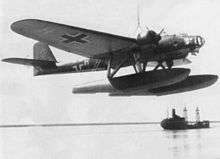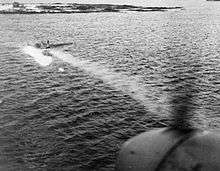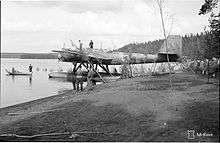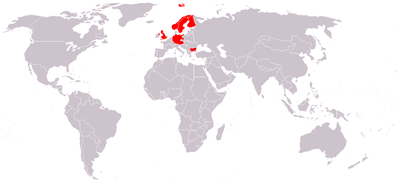Heinkel He 115
| He 115 | |
|---|---|
 | |
| Finnish Air Force He 115 N | |
| Role | Torpedo bomber seaplane |
| Manufacturer | Heinkel |
| First flight | August 1937 |
| Introduction | 1939 |
| Status | Retired |
| Primary users | Luftwaffe Royal Norwegian Navy Air Service Swedish Air Force Royal Air Force Finnish Air Force |
| Number built | 138 |
|
| |
The Heinkel He 115 was a World War II Luftwaffe seaplane with three seats. It was used as a torpedo bomber and performed general seaplane duties, such as reconnaissance and minelaying. The plane was powered by two 960 PS (947 hp, 720 kW) BMW 132K nine-cylinder air-cooled radial engines. Some later models could seat four, had different engines, or used different weapon setups.
Development and design
In 1935, the German Reich Air Ministry (Reichsluftfahrtministerium or RLM) produced a requirement for a twin engined general purpose floatplane, suitable both for patrol and for anti-shipping strikes with bombs and torpedoes. Proposals were received from both Heinkel Flugzeugwerke and from Blohm & Voss' aircraft subsidiary, Hamburger Flugzeugbau, and on 1 November 1935, orders were placed with both Heinkel and Hamburger Flugzeugbau for three prototypes each of their prospective designs, the He 115 and the Ha 140.[1][2]
The first prototype Heinkel flew in August 1937,[1] with testing proving successful, with the He 115 being selected over the Ha 140 early in 1938, resulting in an order for an additional prototype and 10 pre-production aircraft.[1] Meanwhile, the first prototype was used to set a series of international records for floatplanes over 1,000 km (621 mi) and 2,000 km (1,243 mi) closed circuits at a speed of 328 km/h (204 mph).[3]
Armament initially consisted of two 7.92 mm (.312 in) MG 15 machine guns, one in the nose and one in the dorsal position.[1] Later He 115s were fitted with a fixed forward-firing 15 mm or 20 mm MG 151 cannon, and two rearward-firing 7.92 mm (.312 in) MG 17 machine guns in the engine nacelles.[4][5] Ordnance used by He 115 variants included LTF 5 or LTF 6b torpedoes and SD 500 500 kg (1,100 lb) or SC 250 250 kg (550 lb) bombs. Some also carried LMB III or LMA mines.
Operational history
Luftwaffe

At the beginning of the war, the He 115 was used for dropping parachute mines in British waters, normally aiming for narrow passages in close vicinity of heavily trafficked ports on the English south coast. The River Thames was also a prime target. However, the aircraft had its finest moment when operating in the anti-shipping role against the Arctic convoys from bases in Northern Norway. Because these convoys initially lacked air cover, the low speed and comparatively light armament of the He 115 was not such a big problem as it had been over the heavily defended English coastline. Later on, with the appearance of carriers and escort carriers, coupled with new Soviet heavy fighters like the Petlyakov Pe-3bis, the air superiority over the convoys was challenged, and as a result, the torpedo bomber losses increased.

Apart from its use as a minelayer and torpedo bomber, it was also used in the coastal reconnaissance role, and by KG 200 to drop agents behind enemy lines.[6]
Royal Norwegian Navy Air Service
_F.60_of_the_Royal_Norwegian_Navy_Air_Service.jpg)
In response to the rising tensions in Europe, the Norwegian Ministry of Defence had ordered six He 115Ns on 28 August 1939. From 14 July-13 November 1939, all six ordered aircraft were delivered to the Norwegian authorities.[7] The He 115N order was intended to replace the RNoNAS' fleet of 1920s vintage Douglas DT torpedo bombers and the somewhat obsolete Marinens Flyvebaatfabrikk M.F.11, which in 1940 was the RNoNAS' main aircraft.[8]
The Norwegians signed another order of six He 115Ns in December 1939, with delivery estimated to March/April 1940. The delivery of this second order was however pre-empted by the German invasion of Norway on 9 April 1940.[7] At the outbreak of hostilities, the Royal Norwegian Navy Air Service had six He 115Ns in service (F.50, F.52, F.54, F.56, F.58, F.60) spread along the coast from the naval air stations at Sola and Flatøy in the south to the one at Skattøra Naval Air Station outside Tromsø in the north. At the beginning of the invasion, the aircraft at the seaplane base at Hafrsfjord near Stavanger (F.60) was captured by the Germans, but two of the Luftwaffe's He 115s (given the codes F.62 and F.64 in Norwegian service) were in turn seized by an improvised militia unit of Norwegian riflemen at Ørnes in Glomfjord, Nordland and by police officers at Brønnøysund, Nordland. The two aircraft were seized after they ran out of fuel and had to make emergency landings on 10 April. Manned by Norwegian aircrews, they served against their former owners for the duration of the campaign.
Seven Norwegian He-115s, five of them He-115Ns, were employed against German and German-controlled ships (see: HNoMS Uller), as well as providing ground support to the Norwegian Army's offensive on the Narvik Front. On 14 April 1940 three Norwegian He 115s made a successful attack on German Ju-52s at Gullesfjordbotn. Four of the Norwegian aircraft (F.52, F.56, F.58 and F.64) made the journey to the United Kingdom shortly before the 10 June 1940 surrender, a fifth (F.50) escaping to Finland, landing on Lake Salmijärvi in Petsamo.[9] A sixth He 115 (F.54) also tried to make the journey to Britain, but was lost over the North Sea. The last of the Norwegian He 115s, F.62 (one of the two captured German aircraft), was unserviceable at the time of the evacuation and had to be abandoned at Skattøra, later being repaired and flown by the Germans.
Royal Air Force
The four escaped aircraft were at first reformed into the Norwegian Helensburgh Group under Commander Bugge. The exiled Norwegian Cabinet Nygaardsvold made plans soon after arriving in the United Kingdom to use the four He 115 aircraft to perform leaflet dropping missions over Norway. The leaflet mission was to deliver a declaration to the occupied Norwegian people, stating that the Norwegian authorities were re-established in the UK and were rejecting any Nazi German overtures proposing a German-Norwegian peace deal. All four Norwegian He 115s were ordered from Helensburgh to Scapa Flow on 3 July 1940 to carry out the mission, although one had to return to Helensburgh due to engine problems. The three He 115s assembled at Scapa Flow were ordered to fly to Norway and drop the declaration over the cities of Oslo, Bergen and Trondheim. Shortly before the mission was to get under way the British Air Ministry intervened and stopped the expedition, insisting that such an undertaking would be suicidal to attempt with the slow flying He 115s. Three days later, the three Norwegian aircraft returned to Helensburgh.[10]
Three of the Norwegian He 115s (F.56, F.58 and F.64) were subsequently used in covert operations with Norwegian crews off Norway and in the Mediterranean Sea. In British service, the three received new serial numbers: BV184, BV185 and BV187.[7] BV184 was attacked and damaged by two Polish Spitfire fighters over the Bay of Biscay in the spring of 1942 while cooperating with French fishing boats,[11] and later lost in a refuelling fire in the UK.[7] BV185 was destroyed in an Italian air raid on Kalafrana, Malta after flying just one clandestine operation to North Africa.[7] BV187 flew several missions on the North African coast from its base in Malta before finally being attacked and destroyed by two German Bf 109s.[7]
Finnish Air Force

On 8 June 1940, the day after Norwegian forces were ordered to cease hostilities, one He 115 (F.50, deemed technically unfit to be flown to UK), was flown to Finland posing as a civilian aircraft LN-MAB. The plane was interned but the pilot, experienced line captain and naval lieutenant Helge Dahl, and crew were free to leave Finland. From Summer 1941 it was used by the Finnish Air Force's LLv.14, coded HE-115 and named "Jenny", to ferry sissi troops behind Soviet lines. In this role, it proved valuable in a terrain with numerous secluded lakes. It served in this role until ambushed behind enemy lines in East Karelia on 4 July 1943. It took off, but soon had to ditch and the crew was made POW. Two days later the still floating HE-115 was strafed by Finnish Morane-Saulnier 406 fighters. There are reports that the Soviets still salvaged the wreck for evaluation.[7] Two Luftwaffe He 115 C were borrowed for similar operations in 1943 - 44 and operated with German markings by Finnish crew. One was returned in 1944, but the other was surrendered to the Soviets after armistice.
Swedish Air Force
The Swedish Air Force operated 12 He 115A-2s under the local designation T 2, with Air Force numbers 101-112. Another six aircraft were ordered, but never delivered due to the outbreak of World War II. They were sturdy and well liked by their crews, and were not taken out of use until 1952. The Swedish T 2s were kept on duty throughout World War II and made a valuable contribution to protecting and enforcing Swedish neutrality. The T 2s replaced the outdated T 1s (Heinkel HD 16s) in the torpedo bomber role and also served as a regular bomber, for smoke screening and for long-range reconnaissance missions. Five of the 12 T 2s were lost in accidents during their service with the Swedish Air Force.[12]
Variants
Prototypes
Five prototypes were used in the development of the aircraft:
- He 115 V1 August 1937, set eight payload/speed records.
- He 115 V2 November 1937, similar to V1.
- He 115 V3 March 1938, introduced glassed cockpit, which became standard.
- He 115 V4 May 1938, production prototype, introduced struts in place of wires between fuselage and floats.
- He 115 V5 1939.
Production
The basic design of the aircraft remained unchanged during the type's career. The main differences, with a few notable exceptions, were changes in armament and avionics. Also to note is that the 'new' 'E' version, launched when production restarted in 1941, is in fact similar to the 'C'-series, again with the exception of armament changes.
- He 115 A-0 10 pre-production examples, armed with a single machine gun.
- He 115 A-1 added a nose-mounted machine gun.
- He 115 A-2 similar to A-1, exported to Norway and Sweden.
- He 115 A-3 modified weapons bay and changes to the radio equipment.
- He 115 B-0 the 'B'-series introduced the ability to trade fuel and bomb load, as well as the possibility to carry a 1,000 kg (2,200 lb) magnetic mine.
- He 115 B-1 added increased fuel capacity.
- He 115 B-1/R1
- He 115 B-1/R2
- He 115 B-1/R3
- He 115 B-2 had reinforced floats for operation from ice or snow.
- He 115 C-1 introduced additional armament.
- He 11 5C-1/R1
- He 115 C-1/R2
- He 115 C-1/R3
- He 115 C-1/R4
- He 115 C-2 reinforced floats in same manner as B-2.
- He 115 C-3 minelayer version.
- He 115 C-4 torpedo bomber version.
- He 115 D one aircraft fitted with BMW 801C engines rated at 1,147 kW (1,560 PS) each.
- He 115 E-1 similar to the 'C'-series, but with revised armament.
Operators

Specifications (He 115 B-1)
Data from [13]
General characteristics
- Crew: 3
- Length: 17.30 m (56 ft 9 in)
- Wingspan: 22.28 m (73 ft 1 in)
- Height: 6.60 m (21 ft 7.75 in)
- Wing area: 87.5 m² (942 ft²)
- Empty weight: 5,290 kg (11,670 lb)
- Loaded weight: 10,400 kg (22,928 lb)
- Powerplant: 2 × BMW 132K 9-cylinder radial engines, 706 kW (960 PS) each
Performance
- Maximum speed: 327 km/h (203 mph)
- Combat radius: 2,100 km (1,305 mi)
- Service ceiling: 5,200 m (17,100 ft)
- Wing loading: 103.8 kg/m² (21.3 lb/ft²)
- Power/mass: 139 W/kg (0.084 hp/lb)
Armament
- 1 × fixed 7.92 mm (.312 in) MG 17 machine gun and 1 × flexible 7.92 mm (.312 in) MG 15 machine gun in dorsal and nose positions
- Five 250 kg (550 lb) bombs, or two such bombs and one torpedo of 800 kg (1,760 lb)
- One 920 kg (2,030 lb) sea mine.[13]
Surviving aircraft
- He 115 A-2 Werknr. 3043? Recovered from Russia, now in storage with private owner in France.
- He 115 B-1 Werknr. 3896 was recovered from Hafrsfjord in Norway on 2 June 2012. It was part of 1 Staffel, Seefernaufklärungsgruppe 906 (No. 1 Squadron, 906 Maritime Reconnaissance Group), known until February 1941 as Küstenfliegergruppe 906 (906 Coastal Aviation Group), Luftflotte 5. In July 2012 the aircraft was in storage awaiting restoration at the Flyhistorisk Museum, Sola near Stavanger.[14]
- The wreck of a He 115 was located at the bottom of the lake Limingen in Nord-Trøndelag, Norway in 2013.[15]
See also
- Aircraft of comparable role, configuration and era
- Related lists
- List of aircraft of World War II
- List of military aircraft of Germany
- List of military aircraft of Sweden
- List of military aircraft of Norway
- List of aircraft of the Royal Air Force
References
Notes
- 1 2 3 4 Air International February 1987, p.97.
- ↑ Donald 1994, p.108.
- ↑ Air International February 1987, p.96.
- ↑ Air International February 1987, p.101.
- ↑ Air International March 1987, p.155.
- ↑ http://www.stahlbrandt.com/html/history/kg200.html
- 1 2 3 4 5 6 7 Luftwaffe.no: Heinkel He 115 in Norway
- ↑ Hafsten 2003: 87–90
- ↑ FAF in Color: Finnish Air Force Aircraft: Heinkel He 115
- ↑ Hafsten 1991, p. 297
- ↑ Berg 1997: 93
- ↑ Avrosys.nu: T 2 - Heinkel He 115 (1939-1952)
- 1 2 Munson 1983, p. 197.
- ↑ "Heinkel 115 recovered in Norway". Aeroplane. No. August 2012. Cudham: Kelsey Publishing. p. 6. ISSN 0143-7240.
- ↑ http://www.nrk.no/trondelag/1.11216620, (in Norwegian)
Bibliography
- Berg, Ole F. (1997). I skjærgården og på havet – Marinens krig 8. april 1940 – 8. mai 1945 (in Norwegian). Oslo: Marinens krigsveteranforening. ISBN 82-993545-2-8.
- Donald, David (ed). Warplanes of the Luftwaffe. London:Aerospace Publishing, 1994. ISBN 1-874023-56-5.
- Ede, Paul and Moeng, Soph (gen. editors) The Encyclopedia of World Aircraft ISBN 1-85605-705-4
- Hafsten, Bjørn; Arheim, Tom (2003). Marinens Flygevåpen 1912–1944 (in Norwegian). Oslo: TankeStreken AS. ISBN 82-993535-1-3.
- Keskinen, Kalevi and Stenman, Kari Finnish Air Force 1939-1945 ISBN 0-89747-387-6.
- "Last of a Genus...The Heinkel 115". Air International, February 1987, Vol. 32 No. 2. pp. 96–101. ISSN 0306-5634.
- "Last of a Genus...The Heinkel 115 Part Two". Air International, March 1987, Vol. 32 No. 3. pp. 154–156. ISSN 0306-5634.
- Munson, Kenneth. Fighters and Bombers of World War II. London: Peerage Books. 1983. ISBN 0-907408-37-0
- Norrbom, Gösta Att flyga är att leva ISBN unstated
External links
| Wikimedia Commons has media related to Heinkel He 115. |